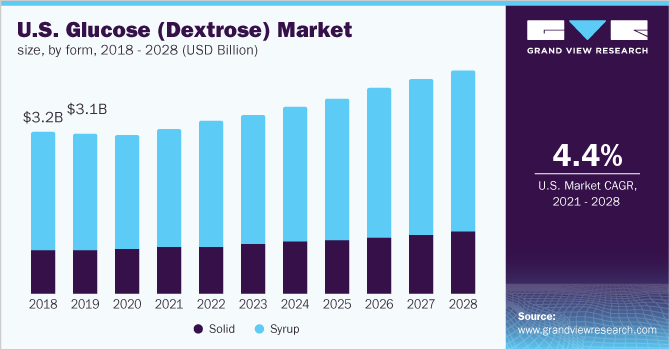Glucose Market Opportunities, and Development Status By 2028
Glucose Industry Overview
The global glucose market size was estimated at USD 42.9 billion in 2020 and is expected to expand at a compound annual growth rate (CAGR) of 5.0% from 2020 to 2028.
The escalating demand for confectionery, soft drink, and bakery products in the food and beverages sector that uses glucose (dextrose) as an ingredient is driving the market. Glucose has its demand across varied industry verticals such as food and beverages, pharmaceutical, cosmetic and personal care, and pulp and paper. It acts as a flavor enhancer, stabilizer, texture enhancer, humectants, adjuncts, preservative, and coating and bulking agent. One of the major properties of glucose is to prevent the crystallization of sugar molecules in confectionaries. These are the benefits associated with glucose which are propelling its demand and usage across the globe.
The glucose syrup segment accounted for the maximum revenue share in the U.S. market. Glucose is majorly derived from corn starch in the U.S. because of the significant availability of corn in the country. Manufacturers can use the glucose syrup/corn syrup in the products because it is enlisted as safe by the FDA under the regulation of 21CFR184.1865. Thus, the syrup segment is having dominance in the market.
Gather more insights about the market drivers, restrains and growth of the Global Glucose Market

Glucose and dextrose are chemically the same and names are often used interchangeably. According to the National Center for Biotechnology Information, glucose is also referred to as dextrose or d-glucose. Dextrose injections are used to treat hypoglycemia, a medical condition where the human blood sugar or glucose level is lower than normal. These injections can also provide extra water and carbohydrates (calories from sugar) to the patient if they are not able to drink a sufficient amount of liquid or an additional quantity of liquid is needed into their body.
The expanding applications of glucose or dextrose in the end-use market are the primary factor bolstering its demand. For instance, glucose usage in the food and beverages sector is widespread as it is used as a sweetener, thickener, and moisture-retaining agent among others. Similarly, in the pharmaceutical industry glucose is used as a treatment of low sugar, acute alcohol intoxication, sulfonylurea overdose, insulin overdose, insulin-induced hypoglycemia in pediatric patients, and high blood potassium or hyperkalemia.
According to cosmeticsinfo.org, a website sponsored by The Personal Care Products Council (PCPC) and its member companies, glucose is used in cosmetics and personal care for various product formulations including skincare and hair care products, bath products, cleaning products, and makeup products. The functions of glucose including flavoring agent, humectant, and skin-conditioning agent among others are contributing to their usage in the respective market.
The covid-19 pandemic has affected the growth of the market because of the lockdowns announced by the respective governments across the countries in order to suppress the spread of the virus. The supply and demand gap created across the international market due to disruption in supply chain models. The per capita income of the countries has been affected for that particular period, which has resulted in decreased sales revenue of the manufacturers across end-use sectors including food and beverages, pharmaceutical, and pulp and paper.
Apart from this, the side effects associated with the excess consumption of added sugar in food items are likely to restrict the growth to an extent over the forecast period from 2020 to 2028. Excess sugar consumption can leads to the accumulation of fat that can turn into fatty liver acid; it can increase the risk of diabetes, as well as heart diseases. The countries like America where a high consumption of sugars is registered are making considerable efforts for lowering its amount in the final food and beverages products.
According to the American Heart Association (AHA), an American adult consumes 77 grams of sugar per day, which is more than three times the recommended amount. The maximum amount of added sugar that should be eaten per day is different for men and women. For men, it is 150 calories per day (equals 37.5g or 9 teaspoons) and for women, around 100 calories per day (equals 25g or 6 teaspoons). Additionally, the AHA has also advised men to not exceed 150 calories of added sugar per day and women should limit their added sugar consumption to 100 calories.
Browse through Grand View Research's Nutraceuticals & Functional Foods Industry Research Reports.
- Confectionery Market - The global confectionery market size was valued at USD 298.23 billion in 2021 and is projected to expand at a compound annual growth rate (CAGR) of 4.3% from 2022 to 2028.
- Bakery Products Market - The global bakery products market size to be valued at USD 251.1 billion by 2025, expanding at a compound annual growth rate (CAGR) of 3.2% during the forecast period.
Market Share Insights
- July 2017: ADM has acquired France-based Chamtor SA, particularly to expand its global share in the starch and sweetener market.
- April 2019: AGRANA Group has announced the construction of a new production facility, which is a joint venture (JV) of AGRANA and a US-based The Amalgamated Sugar Company.
Key Companies profiled:
Some prominent players in the global glucose market include
- Archer Daniels Midland Company (ADM)
- Ingredion Incorporated
- AGRANA Beteiligungs-AG
- Tate & Lyle PLC
- Cargill, Incorporated
- Roquette Frères
- Grain Processing Corporation
- Tereos S.A.
- Fooding Group Limited
- Global Sweeteners Holdings Limited
Order a free sample PDF of the Glucose Market Intelligence Study, published by Grand View Research.
Comments
Post a Comment